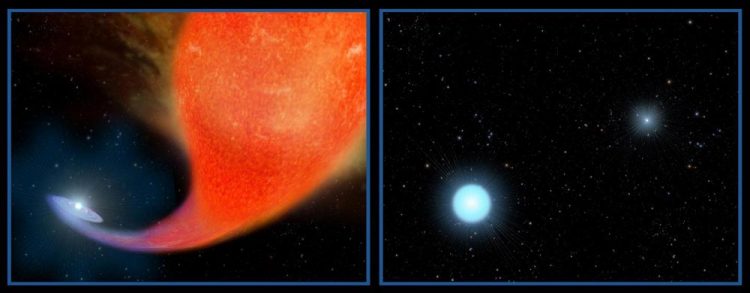Alternative stellar lifestyle: Common, curious, solved at last

Birth of a blue straggler star. Left: A normal star in a binary system gravitationally pulls in matter from an aging companion star that has swelled to a bloated red giant that is a few hundred times its original size. Right: After a couple hundred million years, the red giant star has burned out and collapsed to the white dwarf that shines intensely in ultraviolet wavelengths. The companion star has bulked up on hydrogen siphoned from the red giant to become much hotter, brighter and bluer. Credit: NASA/ESA, A. Feild (STScI)
But half of all stars are in binaries — pairs of stars that orbit each other. Half of binary stars orbit so close that gravitational interaction significantly affects their evolution and demise. Today, scientists led by Robert Mathieu, a professor of astronomy at the University of Wisconsin-Madison, and his former student Natalie Gosnell confirmed one of the possible explanations for a common group of exceptions: the blue stragglers.
Blue stragglers look younger and brighter than their age would suggest — skirting, in other words, the clean, clear rules of stellar evolution. Since their discovery in 1953, blue stragglers have been begging for explanation. Had two stars collided to form a more massive star? Was a blue straggler “stealing” gas from a companion star?
In recent years, based on observations at the WIYN telescope at Kitt Peak, Arizona, Mathieu and his students have established that over three-quarters of blue stragglers, in fact, have stellar companions.
This week, in a paper in The Astrophysical Journal, Gosnell, Mathieu and colleagues identified the orbital partner that was parasitized by the blue straggler. The victim, they found, was a red giant that donated hydrogen gas for eons until it was eventually transformed into a white dwarf — the old, small, bright and dense remnant of a red giant.
The researchers used the Hubble Space Telescope to study the “colors” of far ultraviolet light coming from blue stragglers and their companions. At a distance of 5,500 light years, the blue straggler binary appears as a single point of light, but by analyzing the amount of ultraviolet light, the researchers saw the unmistakable signal of a white dwarf.
The study builds on a series of logical deductions. The stars being studied were identified as members of a binary pair because they periodically move closer to and further from Earth — the hallmark of an orbiting pair of stars. Their optical color and intensity marked them as blue stragglers. They are bright in the far ultraviolet, a trademark of a hot white dwarf. And finally, for the white dwarfs to still be hot and detectable, they can only be 300 million years old. “These blue stragglers were formed 'yesterday,'” says Mathieu.
White dwarfs form when certain stars lose their outer atmospheres. The mass “must be going somewhere,” Gosnell says, “and that's to the companion normal star, which is close enough to attract the mass through gravity. Therefore, the white dwarf is left over after adding mass to a star, which becomes the blue straggler.”
The study expands our understanding of a major area of stellar evolution. If half of all stars are in binaries, and half of the binaries are, like the blue straggler, close enough to have gravitational interaction, then “these stars are not just an afterthought, a contaminant to our neat picture,” Gosnell says. “We need to bring this 25 percent of all stars into the fold, so we can say we really understand how stars evolve.”
If scientists don't know how the blue stragglers formed, they are in a poor position to understand how they will evolve and die, adds Gosnell, who is now a postdoctoral fellow at the University of Texas. “Of course, we still have a third of the blue stragglers to figure out. I think we also have some stellar collisions in there.”
“Our understanding of single-star evolution is one of the great intellectual achievements of the last century,” says Mathieu. “We began with points of light in the sky, and with the application of new instrumentation, the physics breakthroughs of the last century, and computers, we took those points of light and turned them into a narrative of star life.
“For the evolution of single stars like our sun, by and large, we got it right, from birth to death. Now we're starting to do the same thing for the one-quarter of stars that are close-orbiting binaries. This work allows us to talk not about points of light, but about the evolution of galaxies, including our own Milky Way. That's a big deal, and getting it right is an even bigger deal.”
###
David Tenenbaum, 608-265-8549, djtenenb@wisc.edu
Media Contact
All latest news from the category: Physics and Astronomy
This area deals with the fundamental laws and building blocks of nature and how they interact, the properties and the behavior of matter, and research into space and time and their structures.
innovations-report provides in-depth reports and articles on subjects such as astrophysics, laser technologies, nuclear, quantum, particle and solid-state physics, nanotechnologies, planetary research and findings (Mars, Venus) and developments related to the Hubble Telescope.
Newest articles

NASA: Mystery of life’s handedness deepens
The mystery of why life uses molecules with specific orientations has deepened with a NASA-funded discovery that RNA — a key molecule thought to have potentially held the instructions for…

What are the effects of historic lithium mining on water quality?
Study reveals low levels of common contaminants but high levels of other elements in waters associated with an abandoned lithium mine. Lithium ore and mining waste from a historic lithium…

Quantum-inspired design boosts efficiency of heat-to-electricity conversion
Rice engineers take unconventional route to improving thermophotovoltaic systems. Researchers at Rice University have found a new way to improve a key element of thermophotovoltaic (TPV) systems, which convert heat…



